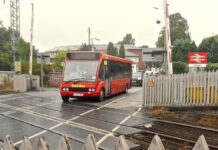A Government minister has said people should “feel safe” travelling on smart motorways, despite – as we reported last week – recently announcing that no more will be installed.
Tory transport minister Richard Holden was speaking during a campaign visit to Stoke-on-Trent ahead of the local elections in May, (ITALICS writes local democracy reporter Richard Price).
Smart motorways have no hard shoulder, meaning all lanes are used by traffic. To make this safe, they have more monitoring equipment than a traditional motorway – such as cameras and digital warning signs.
But there have been calls to scrap them by safety campaigners who say they have led to a “significant” number of fatalities and serious injuries.
Mr Holden, whose constituency is in Durham, said he was a frequent road user but conceded there was a lack of public confidence in smart motorways, including parts of the M6 through Cheshire and Staffordshire, which had led to the Government rethink.
He said: “I do a lot of miles on the roads, I drive to my constituency which is about as far away from London as you can go before you’d decide to fly instead.
“What I’d say about smart motorways is there is a lack of public confidence, or there certainly has been, and that’s why we’re putting £900m into retro-fitting so much stuff.
“That is entirely there to address issues around, say if there is an incident, where you’d pull – and in terms of monitoring, how we monitor them more with the automatic stuff and more modern cameras.
“We’re also getting more traffic officers on the ground. We’re doubling the number of traffic officers across the country, physically on the road, to deal with incidents.”
Mr Holden said this meant there would be at least one safety area per mile on existing smart motorways and described it as “a big step in the right direction”.
He said: “It should give people confidence that if they do face an issue they’re able to move over into a safe area.” Despite being forced to spend close to £1bn on improving them, he nevertheless defended the current smart motorway network.
He said he believed the perception that other types of major road were safer was inaccurate, citing statistics that showed there were three times as many deaths and serious incidents per kilometre on A-roads than on the motorway network.
This, he said, was due to the number and variety of junctions and bends on those roads, whereas motorways were generally straighter and had slip roads for joining traffic.
He highlighted the fact that drivers still broke down in active lanes on old-style motorways, and cautioned that the hard shoulder was also a dangerous place to break down.
He said: “If you travel on a dual carriageway there is no hard shoulder, there never has been.
“You’re still travelling at 70mph but there’s no hard shoulder and there are sharp turnings onto it. The fact that smart motorways have camera monitoring and regular traffic patrols and refuge areas all adds to the safety of them.”
The Royal Society for the Prevention of Accidents said it welcomed the Government’s announcement that no new smart motorways will be built, and said most drivers want the hard shoulder back.
Its road safety manager, Rebecca Guy, said: “It is quite clear that drivers want the return of the hard shoulder, and ultimately we need motorists to feel safe on our roads.
“That’s why we welcome the plans to shelve the planned construction of smart motorways and hope that money will go into making motorways safer in other ways.
“However, an important thing we must remember, is that even where a hard shoulder is in place, live lane breakdowns can still happen, for example, if a motorist in lane three experiences a breakdown and cannot reach the hard shoulder in time.
“A hard shoulder is only a relative place of safety. Collisions and injury still can occur on the hard shoulder, which is why we will continue to educate motorists on what to do if they do find themselves in an emergency on the road.
“We are reassured to hear that investments in existing smart motorway safety features are ongoing, in particular the retrofit of emergency refuge areas which we called for during a
Transport Select Committee evidence session.”
(Photo: LRDS).















